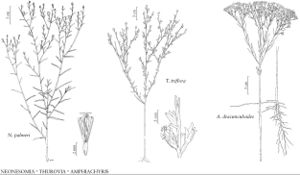Thurovia
Contr. U.S. Natl. Herb. 3: 321. 1895.
| Taxon | Illustrator ⠉ | |
|---|---|---|
 | Neonesomia palmeri Thurovia triflora Amphiachyris dracunculoides | Yevonn Wilson-Ramsey Barbara Alongi Barbara Alongi |
Annuals or perennials, 6–45 cm (eglandular; taprooted or roots spreading laterally in perennials). Stems erect, branched mostly in distal 1/2, glabrous. Leaves cauline; alternate; sessile; blades (1-nerved) linear-filiform, margins entire, faces glabrous. Heads discoid, usually in (secund) spiciform arrays. Involucres narrowly cylindro-obconic, (3–4 ×) 1.5–2 mm. Phyllaries 5–9 in 2 series, 1-nerved (usually convex and without prominent midnerves) outermost linear-oblong and mostly green, oblong-lanceolate, subequal to unequal, white-indurate proximally, proximal margins scarious, (apices acute), faces glabrous. Receptacles flat, shallowly pitted (glabrous), epaleate. Disc-florets 3, bisexual, fertile; corollas white or pale-yellow, tubes shorter than funnelform throats, lobes 5, spreading-recurved, narrowly lanceolate (lengths 1/2 corollas); style-branch appendages linear-lanceolate. Cypselae obconic, subterete, 4-nerved (subdermal, hardly evident), densely and evenly white-sericeous; pappi persistent, of 10 silvery white, ovatelanceolate, erose or apiculate scales in 2 series. x = 5.
Discussion
Species 1.
Thurovia was treated by M. A. Lane (1985) within Gutierrezia; data of Y. Suh and B. B. Simpson (1990) indicated it to be the sister group of Amphiachyris. The species is distinctive in its spiciform arrays of tiny, axillary, few-flowered, discoid heads with white corollas, densely sericeous cypselae, and pappi of scales.
Selected References
Lower Taxa
"[" is not declared as a valid unit of measurement for this property."]" is not declared as a valid unit of measurement for this property.